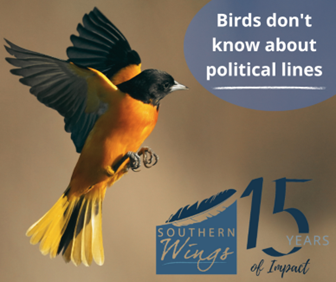
Southern Wings is celebrating its 15-year anniversary in 2024. In those fifteen years, forty-one states have contributed over $4.2 million to the conservation of shared migratory birds through strategic investment on the stopover and nonbreeding grounds, leveraging over $9M in total partner funding. These contributions have been used to conserve, restore, or manage over 1.5M acres of habitat for birds while also supporting clean air, clean water, healthy habitat, and human well-being. Thank you and congratulations to IN, IA, KS, KY, AR, KY, MI, MN, MO, NE, SD, and WI for their support of and leadership for full annual cycle conservation of priority migratory birds through Southern Wings.
Southern Wings supports partnerships that implement habitat conservation, management, and research at stop-over sites and on the wintering or nonbreeding grounds where “our” migrant breeding birds spend up to 8 months of the year. Southern Wings implements full annual cycle conservation that is the same successful model we use for waterfowl conservation, supporting conservation actions south of the US which complement the work already being done across the Midwest in each state.
SOUTHERN WINGS:
• offers an easy, transparent, and flexible process for states to effectively conserve their migratory bird Species of Greatest Conservation Need when they are not in the U.S.;
• is a critical complement to in-state investment on migratory bird stop over and breeding habitats;
• leverages limited state funds;
• can provide non-federal match for State Wildlife Grants and Pittman-Robertson funds; and
• identifies strategic, biologically relevant projects with high quality partners that provide the most bang for your conservation buck.
Although we have had great success conserving waterfowl, 1 in 4 breeding birds have been lost from the United States and Canada in the past 50 years. According to the 2022 US State of the Birds Report, “Birds are declining overall in every habitat except wetlands, where decades of investment have resulted in dramatic gains.” There is a need to have the same scale of investment and commitment to conservation for landbirds, shorebirds, and waterbirds if we are to reverse the observed declines in these groups. Some of the greatest population losses we have seen are among our grassland bird populations. To help reverse these declines, Southern Wings supported partners in the Chihuahuan Desert to work in important focal areas for species such as Sprague’s pipit, long-billed curlews, mountain plovers, and more. In the El Tokio Grassland Priority Conservation Area, the partnership implemented a comprehensive strategy in partnership with local communities that has conserved over 140,000 acres of habitat through invasive plant species removal, grassland restoration, installation of sustainable ranching infrastructure, and conservation easements. In the Valles Centrales Grassland Priority Conservation Area, Bird Conservancy of the Rockies facilitates a partnership that established a Sustainable Grazing Network. It now encompasses almost 700,000 acres. 350,000 acres of grassland habitat have been improved with demonstrated increases in Sprague’s pipits.
Over 140 species of Neotropical migrant use the Caribbean Coast of Guatemala for stop over or nonbreeding habitat. At least 29 of the focal species are Species of Greatest Conservation Need. Implementation of a landscape-scale conservation strategy resulted in almost 11,000 acres of habitat conserved, 33,000 acres leveraged for forest conservation with private landowners and local communities, and the installation of three Motus Wildlife Tracking System (MOTUS) stations. Cerulean warbler, a species whose population has plummeted, is a Species of Greatest Conservation Need in 35 states. Focal areas in South America have been identified as critical to cerulean warbler conservation. The partners created a six-mile corridor between two important montane reserves in the northern Andes of Colombia through restoration, reforestation, and the promotion of shade-grown coffee and cacao. This included planting over 500,000 trees on 2,835 acres across 200 private farms.
To support state agencies as they update their State Wildlife Action Plans (SWAPs), Southern Wings developed tools and template text to integrate annual cycle conservation into your SWAP. Implementation of a conservation strategy that includes conservation action across the full annual cycle of migratory birds is imperative to successfully reverse declines and achieve SWAP objectives. Check out the website for more information and to see our social media toolkit, Impact Report, and 15-year Anniversary Infographic. You or your staff can reach out to Deb Hahn or Bradley Wilkinson to help celebrate Southern Wings through articles or social media posts, discuss integrating annual cycle conservation in your SWAP, or if you have questions about or are interested in participating
